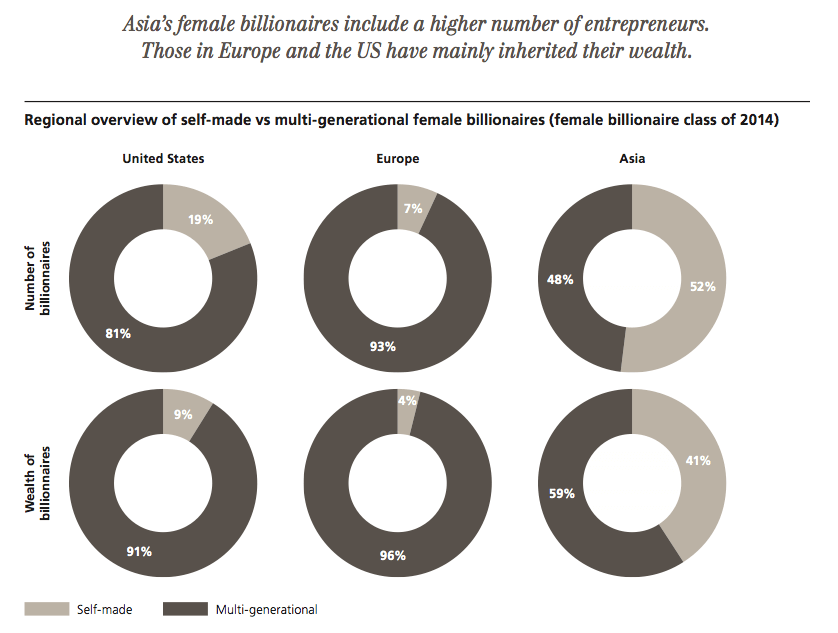UBS Group AG and PwC today launched a joint report, “The changing faces of billionaires,” which explores the role of women in building lasting financial legacies and how the number of female billionaires is starting to outpace males.
The report’s findings, which build upon UBS/PwC’s 2015 Billionaires Report released last May, “Master architects of great wealth and lasting legacies,” revealed that the number of female billionaires is growing faster than the number of their male counterparts. Women have been controlling greater average wealth than men and becoming more influential in family businesses, philanthropic enterprises and governance.
The report also highlights the fleeting nature of great wealth, finding that only 126 billionaires or 44% of the class of 1995 are billionaires today. It underscores the strategies these prevailing billionaires have employed to build and preserve lasting legacies.
“The rise of female and Asian billionaires over the last two decades is creating an entirely new billionaire demographic, and I see no signs of slowing,” said Josef Stadler, Head Global Ultra High Net Worth, UBS. “While there is no such thing as a typical billionaire, virtually all are focused on building a lasting legacy for future generations. Achieving this goal increasingly requires strategic thought and long-term planning.”
“The report suggests that we need to revisit the old saying ‘The first generation builds the business, the second makes it a success, and the third wrecks it’,” said Michael Spellacy, Global Wealth Leader at PwC US. “Our findings reveal that it is in fact the second generation that all too often undermines the value of the business the first generation created. To prevent this, business decisions must move from the kitchen table to the board room.”
Key findings from “The changing faces of billionaires” report include:
The ‘Athena’ Factor
The number of female billionaires is growing faster than male billionaires – multiplying by 6.6x over the last two decades compared to 5.2x for men, with Asian female entrepreneurs standing out as the main driver of this development. Asia has seen the strongest growth of female billionaires in the past 10 years, their numbers grew by a factor of 8.8 from only 3 to 25 today. This compares to a growth factor of 2.7 (from 21 to 57) in Europe and 1.7 or 37 to 63 in the US.
Female billionaires in Asia make up almost one fifth of the global female billionaire population and generally are younger than their global counterparts. By contrast, in Europe and America, females are mostly multi-generational billionaires (93% Europe, 81% US); however, they are also playing much stronger roles than previous generations within their families.
The Volatility of Great Wealth
The report shows that great wealth is very volatile, more than half of the billionaires of 1995 dropped out of the list over the last 20 years. But those who prevailed greatly increased their wealth. Consumer& Retail, Technology and Financial Services are the dominant industries, making up for two-thirds of the total wealth of the lasting billionaires today. The Technology sector in particular is home to the most enduring billionaires while Industrials, Real Estate and Health Industries are sectors where billionaire wealth is more fleeting.
In 1995, the report counted 289 billionaires. From this group of billionaires, only 126 remain today while the others have dropped off the billionaire list due to death, family dilution or business failures. Over the same period, 1,221 new billionaires were created bringing the total number to 1347 billionaires in 2014.
The 126 prevailing billionaires have created US$1 trillion of wealth, approximately 21% of that produced by our entire global billionaire population over the period. By 2014, the average wealth of the remaining billionaires had grown their average wealth to $11bn from $2.9bn in 1995, multiplying their assets by a factor of 3.8 and outperforming global GDP growth of just 2.5.
Our research and analysis consistently identified three personality traits as essential to entrepreneurial success for both genders – smart risk taking, ‘obsessive’ business focus and dogged determination.
Making wealth last
Our report found that the majority of multi-generational billionaires created lasting legacies by keeping the initial business entirely or parts of it. The industry sector often dictates the degree to which one keeps the original business. For instance, the best wealth preservation strategy for billionaires that made their fortune in the Consumer and Retail sector is to maintain control of the original business as a value driver. Finance billionaires, on the other hand, are best served by a combination of retaining the original business and adopting a hybrid strategy.
Two-thirds of billionaires are over 60 years’ of age and face critical wealth transfer decisions. Over three quarters of current billionaires have two or more children. To avoid wealth dilution as the next generation and subsequent generations grow larger, a clear wealth preservation strategy is required to ensure the creation of long term lasting legacies.
Protecting billionaires’ legacies also requires coping with outside forces. Anti-wealth sentiment in politics, growing taxes and increasingly stringent global regulations pose the biggest threats to billionaires’ wealth, topping their list of concerns over potential economic crises, and demonstrating the importance of robust tax and legal capabilities to manage these challenges.
As part of this, the report shows that clear governance structures are necessary to preserve and grow wealth through future generations. To ensure long-term success, managerial competence must override family ties. However, maintaining a strong identity has proven material to long-lasting billionaire family dynasties. This, together with establishing strong governance and a well-resourced family office, is a key factor in building lasting legacies.

